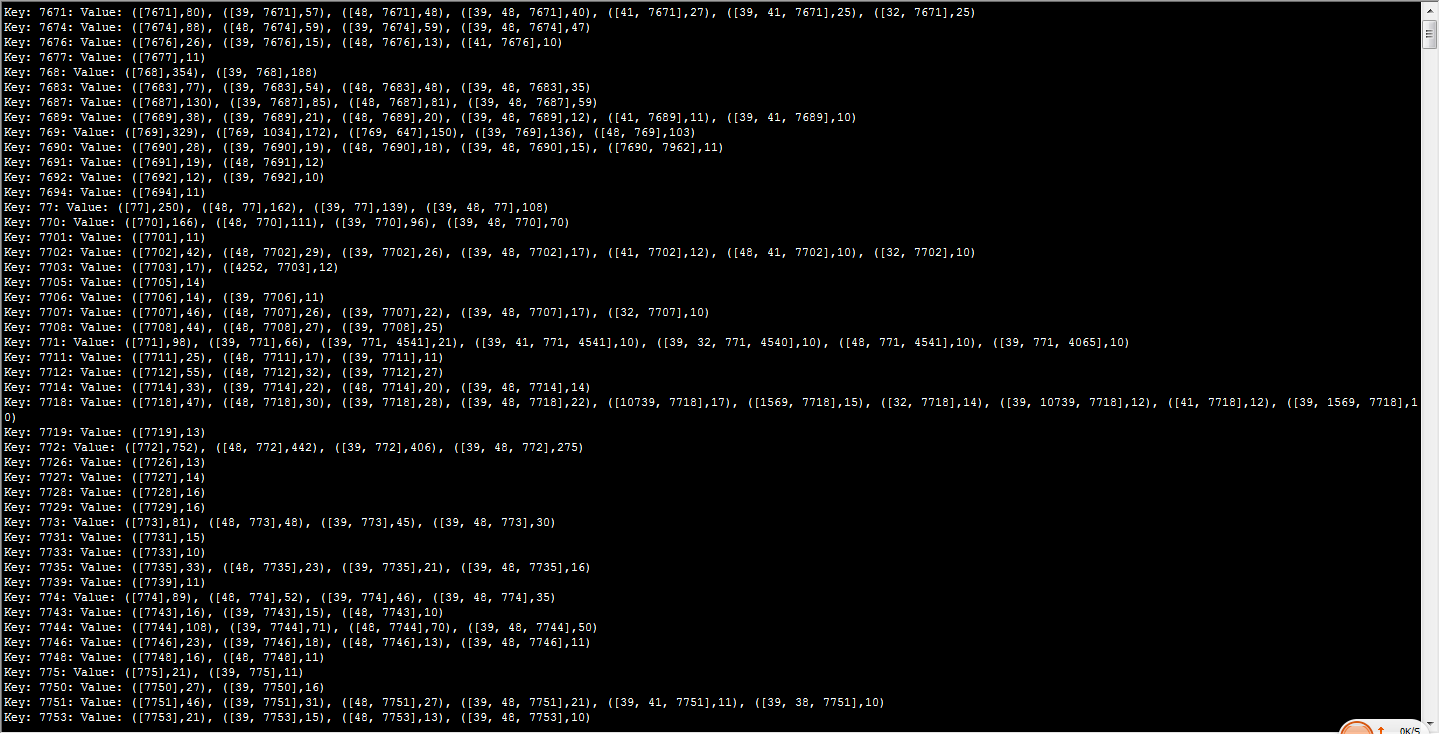使用mahout fpgrowth算法求关联规则
使用mahout
fpgrowth
首先,这篇文章的内容大部分取自国外一篇博客Finding
association rules with Mahout Frequent Pattern Mining,写这个出于几个原因,一 原文是英文的;二该博客貌似还被墙了,反正我是用了goagent才看到的;三 我简化了其实验内容,单纯的用数字表示item了。
首先是实验环境
- jdk >= 1.6
- maven
- hadoop (>1.0.0)
- mahout >= 0.7
环境搭建就不多说了,唯一注意的是mahout按照官网的指导绝对没问题,如果安装之后报错,可能是你的hadoop版本问题,换个hadoop试试,我遇到的错就是一直
Exception in thread "main" java.lang.NoClassDefFoundError:classpath。
我用的数据是mahout官网上提供的retail.dat,使用哪个数据没关系,mahout fpgrowth的数据格式要求如下:
[item id1], [item id2], [item id3]
0, 2, 6, ...
0, 1, 6, ...
4, 5, ...
...
间隔符可以是别的,retail.dat里用的是空格,但要注意的是使用命令行时要标志。
这里不设置MAHOUT_LOCAL,让mahout在hadoop上跑,所以先使用hadoop命令把数据放到hdfs上,在terminal输入:
hadoop fs -put output.dat retail.dat
然后输入如下指令运行mahout:
mahout fpg -i output.dat -o patterns -k 10 -method mapreduce -regex '[\ ]' -s 10
指令的含义在mahout的网站上有详细说明,简要说下,-i表示输入,-o表示输出,-k 10表示找出和某个item相关的前十个频繁项,-method mapreduce表示使用mapreduce来运行这个作业,-regex '[\ ]'表示每个transaction里用空白来间隔item的,-s 10表示只统计最少出现10次的项。
成功运行后在patterns文件夹里会出现四个文件或者文件夹
- fList: 记录了每个item出现的次数的序列文件
- frequentpatterns: 记录了包含每个item的频繁项的序列文件
- fpGrowth
- parallelcounting
当然这些结果是在hdfs上面的,可以使用mahout命令查看下这些输出,在终端输入 mahout seqdumper -i patterns/frequentpatterns/part-r-00000

第一行显示了与item7671有关的前十个事务(按出现次数排序), ([7671],80) 表示item7671出现在80个事务中. ([39, 7671],57) 表示39和7671这两个item同时出现在57个事务里。关联规则可以由以下几个参数来推导:
- support
包含集合X的事务出现的频率:
- confidence
包含x的事务中含有同时包含Y的比例:
- lift 用来表示X和Y的相互独立程度:
- conviction 也是用来衡量X和Y的独立性的,这个值越大越好:
下面用程序来推导关联规则,先把hdfs上面的几个文件放到本地来,
hadoop fs -getmerge patterns/frequentpatterns frequentpatterns.seq
hadoop fs -get patterns/fList fList.seq
代码是java代码,怎么建工程都行,我是用的eclipse+maven,因为这样它可以自动帮我下载所需要的mahout的包,把两个序列文件拷到工程的根目录下,代码如下

package heyong; import java.util.ArrayList;
import java.util.HashMap;
import java.util.List;
import java.util.Map; import org.apache.hadoop.conf.Configuration;
import org.apache.hadoop.fs.FileSystem;
import org.apache.hadoop.fs.Path;
import org.apache.hadoop.io.LongWritable;
import org.apache.hadoop.io.SequenceFile;
import org.apache.hadoop.io.SequenceFile.Reader;
import org.apache.hadoop.io.Text;
import org.apache.mahout.common.Pair;
import org.apache.mahout.fpm.pfpgrowth.convertors.string.TopKStringPatterns; public class ResultReaderS {
public static Map<Integer, Long> readFrequency(Configuration configuration, String fileName) throws Exception {
FileSystem fs = FileSystem.get(configuration);
Reader frequencyReader = new SequenceFile.Reader(fs,
new Path(fileName), configuration);
Map<Integer, Long> frequency = new HashMap<Integer, Long>();
Text key = new Text();
LongWritable value = new LongWritable();
while(frequencyReader.next(key, value)) {
frequency.put(Integer.parseInt(key.toString()), value.get());
}
return frequency;
} public static void readFrequentPatterns(
Configuration configuration,
String fileName,
int transactionCount,
Map<Integer, Long> frequency,
double minSupport, double minConfidence) throws Exception {
FileSystem fs = FileSystem.get(configuration); Reader frequentPatternsReader = new SequenceFile.Reader(fs,
new Path(fileName), configuration);
Text key = new Text();
TopKStringPatterns value = new TopKStringPatterns(); while(frequentPatternsReader.next(key, value)) {
long firstFrequencyItem = -1;
String firstItemId = null;
List<Pair<List<String>, Long>> patterns = value.getPatterns();
int i = 0;
for(Pair<List<String>, Long> pair: patterns) {
List<String> itemList = pair.getFirst();
Long occurrence = pair.getSecond();
if (i == 0) {
firstFrequencyItem = occurrence;
firstItemId = itemList.get(0);
} else {
double support = (double)occurrence / transactionCount;
double confidence = (double)occurrence / firstFrequencyItem;
if ((support > minSupport
&& confidence > minConfidence)) {
List<String> listWithoutFirstItem = new ArrayList<String>();
for(String itemId: itemList) {
if (!itemId.equals(firstItemId)) { listWithoutFirstItem.add(itemId);
}
}
String firstItem = firstItemId;
listWithoutFirstItem.remove(firstItemId);
System.out.printf(
"%s => %s: supp=%.3f, conf=%.3f",
listWithoutFirstItem,
firstItem,
support,
confidence); if (itemList.size() == 2) {
// we can easily compute the lift and the conviction for set of
// size 2, so do it
int otherItemId = -1;
for(String itemId: itemList) {
if (!itemId.equals(firstItemId)) {
otherItemId = Integer.parseInt(itemId);
break;
}
}
long otherItemOccurrence = frequency.get(otherItemId);
double lift = (double)occurrence / (firstFrequencyItem * otherItemOccurrence);
double conviction = (1.0 - (double)otherItemOccurrence / transactionCount) / (1.0 - confidence);
System.out.printf(
", lift=%.3f, conviction=%.3f",
lift, conviction);
}
System.out.printf("\n");
}
}
i++;
}
}
frequentPatternsReader.close(); } public static void main(String args[]) throws Exception { int transactionCount = 88162;//事务总数
String frequencyFilename = "data/fList.seq";//
String frequentPatternsFilename = "data/frequentpatterns.seq";
double minSupport = 0.001;//支持度
double minConfidence = 0.3;//置信度 Configuration configuration = new Configuration();
Map<Integer, Long> frequency = readFrequency(configuration, frequencyFilename);
readFrequentPatterns(configuration, frequentPatternsFilename,
transactionCount, frequency, minSupport, minConfidence); }
}

程序运行得到如下的结果
[39] => 3361: supp=0.003, conf=0.565, lift=0.000, conviction=0.977
[48] => 3361: supp=0.003, conf=0.560, lift=0.000, conviction=1.186
[39, 48] => 3361: supp=0.002, conf=0.396
[48] => 337: supp=0.001, conf=0.589, lift=0.000, conviction=1.271
[39] => 337: supp=0.001, conf=0.554, lift=0.000, conviction=0.952
[48] => 338: supp=0.009, conf=0.611, lift=0.000, conviction=1.344
[39] => 338: supp=0.008, conf=0.582, lift=0.000, conviction=1.018
[39, 48] => 338: supp=0.006, conf=0.405
[48] => 340: supp=0.005, conf=0.633, lift=0.000, conviction=1.422
………………
调整支持度和置信度的值,可以增强结果的满意度。至此,完成了使用mahout fpgrowth推导规则的一次入门实验室,灵活使用这个算法,还是可以在很多地方派上用场的。
我的实践:
数据:
I1 I2 I5
I2 I4
I2 I3
I1 I2 I4
I1 I3
I2 I3
I1 I3
I1 I2 I3 I5
I1 I2 I3
调用命令:
mahout fpg -i /user/hdfs/fp-growth/in/fpg.txt -o /user/hdfs/fp-growth/out -k 50 -method mapreduce -regex '[\ ]' -s 2
打印结果:
mahout seqdumper -i /user/hdfs/fp-growth/out/frequentpatterns/part-r-00000
Input Path: /user/hdfs/fp-growth/out/frequentpatterns/part-r-00000
Key: I1: Value: ([I1],6), ([I2, I1],4), ([I1, I3],4), ([I2, I1, I5],2), ([I2, I1, I3],2)
Key: I2: Value: ([I2],7), ([I2, I3],4), ([I2, I1],4), ([I2, I1, I5],2), ([I2, I1, I3],2), ([I2, I4],2)
Key: I3: Value: ([I3],6), ([I2, I3],4), ([I1, I3],4), ([I2, I1, I3],2)
Key: I4: Value: ([I2, I4],2)
Key: I5: Value: ([I2, I1, I5],2)
Count: 5
使用mahout fpgrowth算法求关联规则的更多相关文章
- Mahout源码分析:并行化FP-Growth算法
FP-Growth是一种常被用来进行关联分析,挖掘频繁项的算法.与Aprior算法相比,FP-Growth算法采用前缀树的形式来表征数据,减少了扫描事务数据库的次数,通过递归地生成条件FP-tree来 ...
- 数据挖掘算法之关联规则挖掘(二)FPGrowth算法
之前介绍的apriori算法中因为存在许多的缺陷,例如进行大量的全表扫描和计算量巨大的自然连接,所以现在几乎已经不再使用 在mahout的算法库中使用的是PFP算法,该算法是FPGrowth算法的分布 ...
- 数据挖掘系列(2)--关联规则FpGrowth算法
上一篇介绍了关联规则挖掘的一些基本概念和经典的Apriori算法,Aprori算法利用频繁集的两个特性,过滤了很多无关的集合,效率提高不少,但是我们发现Apriori算法是一个候选消除算法,每一次消除 ...
- 数据挖掘进阶之关联规则挖掘FP-Growth算法
数据挖掘进阶之关联规则挖掘FP-Growth算法 绪 近期在写论文方面涉及到了数据挖掘,需要通过数据挖掘方法实现软件与用户间交互模式的获取.分析与分类研究.主要涉及到关联规则与序列模式挖掘两块.关联规 ...
- 关联规则之FpGrowth算法
Aprori算法利用频繁集的两个特性,过滤了很多无关的集合,效率提高不少,但是我们发现Apriori算法是一个候选消除算法,每一次消除都需要扫描一次所有数据记录,造成整个算法在面临大数据集时显得无能为 ...
- 使用 FP-growth 算法高效挖掘海量数据中的频繁项集
前言 对于如何发现一个数据集中的频繁项集,前文讲解的经典 Apriori 算法能够做到. 然而,对于每个潜在的频繁项,它都要检索一遍数据集,这是比较低效的.在实际的大数据应用中,这么做就更不好了. 本 ...
- 使用Apriori算法和FP-growth算法进行关联分析
系列文章:<机器学习实战>学习笔记 最近看了<机器学习实战>中的第11章(使用Apriori算法进行关联分析)和第12章(使用FP-growth算法来高效发现频繁项集).正如章 ...
- 关联分析Apriori算法和FP-growth算法初探
1. 关联分析是什么? Apriori和FP-growth算法是一种关联算法,属于无监督算法的一种,它们可以自动从数据中挖掘出潜在的关联关系.例如经典的啤酒与尿布的故事.下面我们用一个例子来切入本文对 ...
- 机器学习之Apriori算法和FP-growth算法
1 关联分析 无监督机器学习方法中的关联分析问题.关联分析可以用于回答"哪些商品经常被同时购买?"之类的问题. 2 Apriori算法 频繁项集即出现次数多的数据集 支持度 ...
随机推荐
- Vim的map
linux系统下.vimrc文件(这个文件可以在家目录新建): 这个文件记录着vim的配置信息: 如: "显示行号 set number "键映射map “如按F5,在word的前 ...
- 学习HTML5
CSS,层叠样式表,能为网页增添样式的电脑语言. UL属于无序列表 OL属于有序列表 DL属于自定义列表.
- 从request中读数据流
ServletInputStream servletInputStream = reqeust.getInputStream(); int len=0; int size=reqeust.getCon ...
- Nginx 0.7.x + PHP 5.2.6(FastCGI)+ MySQL 5.1 在128M小内存VPS服务器上的配置优化
对其用户和应用程序来讲,每一个VPS平台的运行和管理都与一台独立主机完全相同,因为每一个VPS均可独立进行重启并拥有自己的root访问权限.用户.IP地址.内存.过程.文件.应用程序.系统函数库以及配 ...
- linux应用之ntpdate命令联网同步时间
当Linux服务器的时间不对的时候,可以使用ntpdate工具来校正时间. 安装:yum install ntpdate ntpdate简单用法: # ntpdate ip # ntpdate 210 ...
- qt和makefile学习网址
http://blog.51cto.com/zt/20/1/ ---qt学习网站 http://www.chinaunix.net/old_jh/23/408225.html [精华] 跟我一起 ...
- 关于React前端构建的一般过程 - 理论篇
概要 本文以个人阅读实践经验归纳前端架构构建过程,以Step by Step方式说明创建一个前端项目的过程.并会对每个阶段所使用的技术进行可替代分析,如Express替换Hapi或者Koa的优缺点分析 ...
- BEC listen and translation exercise 44
But over the past 70 years or so, there's been a massive increase in one type of crime which was wha ...
- ffmpeg 纯静态编译,以及添加自定义库流程摘要
需求: 1. 纯静态编译ffmpeg ,即ldd ./ffmpeg 的结果是:not a dynamic executable 2. 修改ffmpeg 项目,添加自定义功能库 3. ...
- BZOJ2286 [Sdoi2011]消耗战 和 BZOJ3611 [Heoi2014]大工程
2286: [Sdoi2011]消耗战 Time Limit: 20 Sec Memory Limit: 512 MBSubmit: 6371 Solved: 2496[Submit][Statu ...
